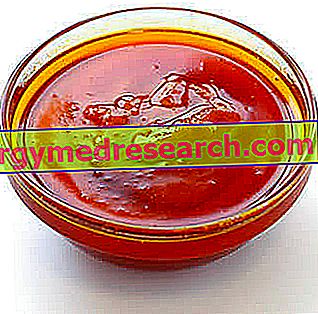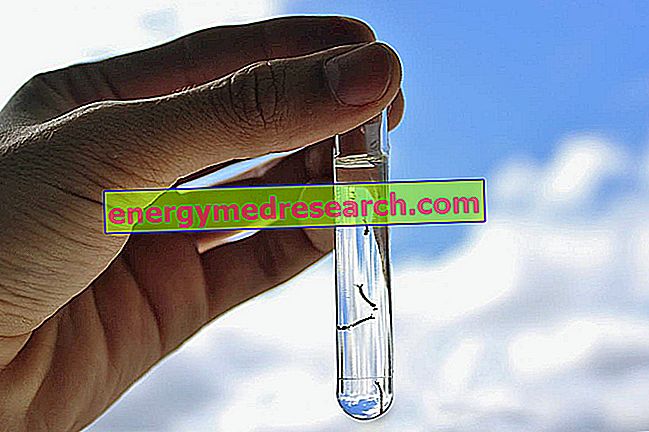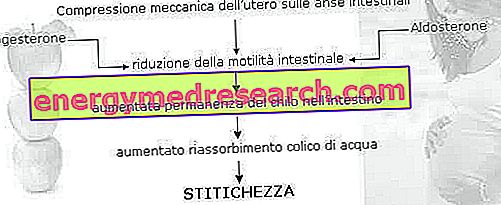What is palm fat?
Palm fat (also known as dendê oil, from the Portuguese "dɛnde") is an edible vegetable oil, obtained from the mesocarp (red pulp) of the fruit of oil palms.
Note : from a technical-food point of view it can be considered both an oil and a fat.

What does palm fat produce?
For the production of palm fat, mainly African oil palms (Genus Elaeis, species guineensis ) are used, but to a lesser extent also the American palms ( Elaeis oleifera ) and the maripa palm ( Attalea maripa ).
Description
Palm fat is naturally reddish in color, due to the high beta-carotene content (provitamin A), and has a very dense, semi-solid consistency at room temperature, due to the high content of saturated fatty acids (approximately 49%).
The palm fat should not be confused with palm kernel oil, derived from the seed of the same fruit, or with coconut oil, derived from the fruit of the coconut palm (Genus Cocos, nucifera species). The main differences between palm fat, palm kernel oil and coconut oil are:
- Color: red in that of palm (we reiterate, due to its content in carotenoids) and translucent in that of palm kernel and coconut
- Consistency: dense in palm but almost solid in that of palm kernel and coconut, which contain 81% and 86% of saturated fats.
However, to facilitate industrial use in food, “raw” palm fat is often refined, decoloured and deodorized to obtain RBD palm oil, transparent, odorless and tasteless.
Nutritional values
Chemical composition of palm fat
Fatty acids
That of palm, like all fats, is mainly composed of esterified fatty acids (1 to 3) to a glycerol molecule.
It has a very high concentration of saturated fatty acids (49%), in particular palmitic acid (16 carbon atoms) from which the name originates. The fraction of monounsaturated oleic acid is also quite high.
Unrefined palm fat is a significant source of tocotrienol (or tocopherol), one of the various forms of vitamin E, and beta-carotene, a pro-vitamin A.
Note : tocotrienols and carotenoids are powerful antioxidants.
The approximate concentration of esterified fatty acids in palm oil is as follows:
| Palm oil fatty acid content (present as triglyceride esters) | |
Type of fatty acid | Percentage |
C14 saturated myristic | 1.0% |
Saturated palmitic C16 | 43.5% |
Saturated Stearic C18 | 4.3% |
C18 monounsaturated oil | 36.6% |
Polyunsaturated Linoleic C18 | 9.1% |
Other / Unknown | 5.5% |
Carotenoids
The red palm fat is rich in carotenoids, such as alpha-carotene, beta-carotene and lycopene, which give it a characteristic deep red pigment. However, refined, bleached and deodorized palm fat (called RBD) does not contain carotenoids.
Nutritional Properties
Nutritional characteristics
Palm fat is an important energy source for poor communities in some less developed countries. Much of the palm fat consumed as a food is in the form of cooking oil, somehow processed and not raw. This degree of refining seems to be responsible for the health risk associated with excessive consumption of palm fat.
In 2015, global per capita consumption of palm fat was estimated at 7.7 kg.
Palmitic acid from palm fat and health
According to studies conducted at the Center for Science in the Public Interest (CSPI), excessive intake of palmitic acid, which makes up 44% of palm fat, increases blood cholesterol levels and can contribute to the onset of vascular diseases.
The US "World Health Organization (WHO)" and "National Heart, Lung and Blood Institute" are therefore encouraging consumers to limit consumption of palmitic acid and foods high in saturated fat. According to the WHO, the consumption of palmitic acid increases the risk of developing cardiovascular diseases in the same way as hydrogenated and trans fatty acids.
Comparison with hydrogenated and trans fats
In response to negative reports on palm fat, many food manufacturers have switched back to using hydrogenated vegetable oils in their products. A 2006 study supported by the "National Institutes of Health" and "USDA Agricultural Research Service" concluded that palm fat is not to be considered a good substitute for partially hydrogenated fats in the food industry because, similarly to saturated and hydrogenated fats rich in trans, causes negative changes in the blood concentrations of LDL cholesterol and apolipoprotein B. However, according to two reports published in 2010 by the Journal of the American College of Nutrition, palm fat can instead be accepted as a valid alternative to rich hydrogenates of trans acids. There is still not much clarity on the matter, but certainly, even if it is considered suitable for human consumption, the refined palm is certainly not to be considered an excellent product.
Comparison with saturated fats of animal origin
Not all palm fats are equally hypercholesterolemic. Studies have shown that the consumption of olein (more unsaturated than other fractions) reduces blood cholesterol compared to saturated fat sources such as coconut oil, milk triglycerides and meat.
Processing and Use
Refining palm fat
After pressing several products are differentiated by some refining processes. The first is fractionation, with crystallization and separation processes to obtain solid fractions (stearin) and liquid fractions (olein). Fusion and degassing follow in order to remove impurities. Then the fat is filtered and bleached.
Physical refining is necessary to eliminate odors and correct color, obtaining RBD palm fat; residual free fatty acids are destined for the manufacture of detergents.
RBD palm fat is the most sold in the world in this category. Many companies further fractionate palm fat to make cooking oil or turn it into other products.
Use of palm fat
Palm fat is a very common ingredient in rural cuisine throughout the tropical African, Southeast Asian and many parts of Brazil.
In the rest of the world, the use of palm fat is however of great economic interest, albeit limited (so to speak) to the food industry; this commercial choice is justified by moderate costs and high chemical-physical stability in the application of frying.
Many processed foods contain palm fat or different ingredients derived from it.
As mentioned, a study carried out on the world population reported that in 2015 as many as 7.7 kg of palm fat per person were consumed.
Red palm fat
Since the mid-1990s, red palm fat has been produced by cold pressing and bottling for use in the kitchen, mixed in mayonnaise or other sauces or as a raw condiment, for example for salads.
Substitute for butter and hydrogenated fats
The highly saturated nature of palm fat makes it solid at room temperature even in temperate regions, making it an economic substitute for butter or hydrogenated fats (for example in pastry production and many bakery products).
A more recent increase in the use of palm fat in the food industry is partly due to the change in labeling requirements, which resulted in the abandonment of hydrogenated fats.
Palm fat is considered a reasonable compromise for avoiding hydrogenates in food, although a small study conducted in 2009 noted that palm can not be used lightly in individuals with already high levels of LDL cholesterol (called bad cholesterol) . The United States Department of Agriculture agricultural research service - USDA - claims that palm fat is not a valid substitute for hydrogenated fats.



